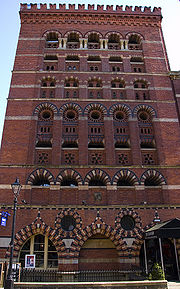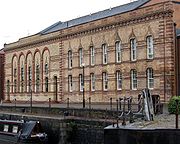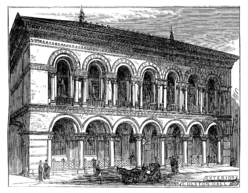
Bristol Byzantine
Encyclopedia

Bristol
Bristol is a city, unitary authority area and ceremonial county in South West England, with an estimated population of 433,100 for the unitary authority in 2009, and a surrounding Larger Urban Zone with an estimated 1,070,000 residents in 2007...
from about 1850 to 1880.
Many buildings in the style have been destroyed or demolished, but notable surviving examples include the Colston Hall
Colston Hall
The Colston Hall is a concert hall and grade II listed building situated on Colston Street, Bristol, England. A popular venue catering for a variety of different entertainers, it seats approximately 2,075 and provides licensed bars, a café and restaurant....
, the Granary on Welsh Back
Granary, Bristol
The Granary is on Welsh Back, Bristol, England.It was built in 1869 by Archibald Ponton and William Venn Gough with red Cattybrook brick with black and white brick and limestone dressings as a granary but has been used as offices. It is probably the best preserved example of the Bristol Byzantine...
, the Carriage Works
Carriage Works, Bristol
The Carriage Works are in Stokes Croft, Bristol, England.It was built in 1862 by Edward William Godwin. The ground-floor arches were originally open for access by John Perry and Sons' carriages....
, in Stokes Croft
Stokes Croft
Stokes Croft is the name of a road and an area in Bristol, England. The road forms part of the A38 that leads north from the city centre, before it takes the names Cheltenham Road and then Gloucester Road...
and several of the buildings around Victoria Street. Several of the warehouses around the harbour have survived including the Arnolfini
Arnolfini
The Arnolfini is an arts centre and gallery in Bristol, England. It has a programme of contemporary art exhibitions, live art, music and dance events, poetry and book readings, talks, lectures and cinema. There is also a specialist art bookshop and a café bar. Educational activities are undertaken...
which now houses an art gallery. Clarks Wood Company warehouse
Clarks Wood Company warehouse
The Clarks Wood Company warehouse is a 19th-century industrial building in Silverthorne Lane, Bristol.It dates from about 1863, but only two of its original walls remain...
and the St Vincent's Works
St Vincent's Works
The St Vincent's Works is at Silverthorne Lane in Bristol, England.The building was built as the offices of a factory by Thomas Royse Lysaght, for his brother John Lysaght and possibly completed by R Milverton Drake. The site was previously owned by Acraman and Company and was involved in the...
in Silverthorne Lane and the Wool Hall
Wool Hall, Bristol
The Wool Hall in Bristol, England, is an historic building in St Thomas Street, constructed in 1830 to house the city's wool market. It is one of the earlier works of Richard Shackleton Pope, and has been described as 'the first quasi-industrial building in Bristol to attempt a real architectural...
in St Thomas Street are other survivors from the 19th century.
Style
Bristol Byzantine has influences from ByzantineByzantine architecture
Byzantine architecture is the architecture of the Byzantine Empire. The empire gradually emerged as a distinct artistic and cultural entity from what is today referred to as the Roman Empire after AD 330, when the Roman Emperor Constantine moved the capital of the Roman Empire east from Rome to...
and Moorish architecture
Moorish architecture
Moorish architecture is the western term used to describe the articulated Berber-Islamic architecture of North Africa and Al-Andalus.-Characteristic elements:...
applied mainly to industrial buildings such as warehouses and factories.
The style is characterised by a robust and simple outline, materials with character and colour including red, yellow black and white brick primarily from the Cattybrook Brickpit
Cattybrook Brickpit
Cattybrook Brickpit is a 2.2 hectare geological Site of Special Scientific Interest near the village of Almondsbury, South Gloucestershire, notified in 1989.-Source:*...
.
Several buildings included archways and upper floors unified through either horizontal or vertical grouping of window openings.
The first building with some of the characteristics generally thought of a Bristol Byzantine is Bush House, which is now known as the Arnolfini
Arnolfini
The Arnolfini is an arts centre and gallery in Bristol, England. It has a programme of contemporary art exhibitions, live art, music and dance events, poetry and book readings, talks, lectures and cinema. There is also a specialist art bookshop and a café bar. Educational activities are undertaken...
a 19th century Grade II* listed tea
Tea
Tea is an aromatic beverage prepared by adding cured leaves of the Camellia sinensis plant to hot water. The term also refers to the plant itself. After water, tea is the most widely consumed beverage in the world...
warehouse situated on the side of the Floating Harbour in Bristol city centre
Bristol city centre
Bristol city centre is the commercial, cultural and business centre of Bristol, England. It is the area south of the central ring road and north of the Floating Harbour, bounded north by St Pauls and Easton, east by Temple Meads and Redcliffe, and west by Clifton and Canon's Marsh...
. The architect was Richard Shackleton Pope
Richard Shackleton Pope
Richard Shackleton Pope was a British architect working mainly in Bristol. His father was a clerk of works for Sir Robert Smirke, and Pope succeeded him, also working for C.R. Cockerell...
, who constructed first the south part of the warehouse (1831) then extended it to the north in 1835-6. It has a rock-faced plinth, three storeys of rectangular windows recessed within tall round arches, and a shallow attic.
The style may have come about as a result of the an acquaintance between William Venn Gough
William Venn Gough
William Venn Gough was an architect responsible for a number of prominent buildings in Bristol. His works include the Cabot Tower, Colston's Girls' School, Trinity Road Library, and Port of Bristol Authority Docks Office, now Queen Square House, in Queen Square.From 1872 he had an office at...
and Archibald Ponton, who designed the Granary
Granary, Bristol
The Granary is on Welsh Back, Bristol, England.It was built in 1869 by Archibald Ponton and William Venn Gough with red Cattybrook brick with black and white brick and limestone dressings as a granary but has been used as offices. It is probably the best preserved example of the Bristol Byzantine...
and John Addington Symonds
John Addington Symonds
John Addington Symonds was an English poet and literary critic. Although he married and had a family, he was an early advocate of male love , which he believed could include pederastic as well as egalitarian relationships. He referred to it as l'amour de l'impossible...
the Bristol-born historian of the Italian renaissance
Italian Renaissance
The Italian Renaissance began the opening phase of the Renaissance, a period of great cultural change and achievement in Europe that spanned the period from the end of the 13th century to about 1600, marking the transition between Medieval and Early Modern Europe...
. The term Bristol Byzantine is thought to have been invented by Sir John Summerson
John Summerson
Sir John Newenham Summerson CH CBE was one of the leading British architectural historians of the 20th century....
.
Architects

- R. Milverton Drake
- ? Foster
- William Bruce GingellWilliam Bruce GingellWilliam Bruce Gingell was an architect practicing in Bristol.He was in partnership with John Henry Hirst for a time and was influential in the Bristol Byzantine architectural style.- Significant buildings :* Gardiners warehouse...
- Edward William GodwinEdward William GodwinEdward William Godwin was a progressive English architect-designer, who began his career working in the strongly polychromatic "Ruskinian Gothic" style of mid-Victorian Britain, inspired by The Stones of Venice, then moved on to provide designs in the "Anglo-Japanese taste" of the Aesthetic...
- William Venn GoughWilliam Venn GoughWilliam Venn Gough was an architect responsible for a number of prominent buildings in Bristol. His works include the Cabot Tower, Colston's Girls' School, Trinity Road Library, and Port of Bristol Authority Docks Office, now Queen Square House, in Queen Square.From 1872 he had an office at...
- John Henry Hirst
- Thomas Royse Lysaght
- Archibald Ponton
- Richard Shackleton PopeRichard Shackleton PopeRichard Shackleton Pope was a British architect working mainly in Bristol. His father was a clerk of works for Sir Robert Smirke, and Pope succeeded him, also working for C.R. Cockerell...
- ? Wood
Examples of buildings in the Byzantine architecture style

- 35 King Street35 King Street, BristolThe 35 King Street is in King Street, Bristol, England.It was built around 1870 and is an example of the Bristol Byzantine style.It has been designated by English Heritage as a grade II listed building....
(c. 1870) - Brown's RestaurantBrown's RestaurantBrown's Restaurant is on Queens Street, Bristol. It is currently occupied by the restaurant chain of the same name, Browns Restaurants.It was built between 1867 and 1871 by Foster and Archibald Ponton. It was constructed with yellow brick with red brick decoration and limestone dressings, and has...
(1871) - Carriage WorksCarriage Works, BristolThe Carriage Works are in Stokes Croft, Bristol, England.It was built in 1862 by Edward William Godwin. The ground-floor arches were originally open for access by John Perry and Sons' carriages....
(1862) - Clarks Wood Company warehouseClarks Wood Company warehouseThe Clarks Wood Company warehouse is a 19th-century industrial building in Silverthorne Lane, Bristol.It dates from about 1863, but only two of its original walls remain...
(1863) - Colston HallColston HallThe Colston Hall is a concert hall and grade II listed building situated on Colston Street, Bristol, England. A popular venue catering for a variety of different entertainers, it seats approximately 2,075 and provides licensed bars, a café and restaurant....
(1860s) - Former Gardiners officesFormer Gardiners officesThe Former Gardiners offices is on Old Bread Street, Bristol, England.It was built in 1865-7 by Foster and Wood and is an example of the Bristol Byzantine style.It has been designated by English Heritage as a grade II listed building....
(1865–1867) - Gardiners warehouseGardiners warehouseThe Gardiners warehouse is on Straight Street, Broad Plain, Bristol, England.It was built in 1865 by William Bruce Gingell and is an example of the Bristol Byzantine style. It was originally part of Christopher Thomas and Brothers' soap works, but is now a warehouse...
(1865) - Granary, BristolGranary, BristolThe Granary is on Welsh Back, Bristol, England.It was built in 1869 by Archibald Ponton and William Venn Gough with red Cattybrook brick with black and white brick and limestone dressings as a granary but has been used as offices. It is probably the best preserved example of the Bristol Byzantine...
(1869) - Robinson's WarehouseRobinson's Warehouse, BristolRobinson's Warehouse is a warehouse on Bathurst Parade, on the Floating Harbour in Bristol, England.It was built in 1874 by William Bruce Gingell, and is an example of the Bristol Byzantine style with yellow and red brick and Moorish arches....
(1874) - St Vincent's WorksSt Vincent's WorksThe St Vincent's Works is at Silverthorne Lane in Bristol, England.The building was built as the offices of a factory by Thomas Royse Lysaght, for his brother John Lysaght and possibly completed by R Milverton Drake. The site was previously owned by Acraman and Company and was involved in the...
- Warehouse premises of Hardware (Bristol) LimitedWarehouse premises of Hardware (Bristol) LimitedThe Warehouse premises of Hardware Limited is on Old Bread Street, Bristol, England.It was built in 1882 by William Bruce Gingell in red brick with white and black brick details and is an example of the Bristol Byzantine style. It was originally part of Christopher Thomas and Brothers' soap...
(1882) - Wool Hall, BristolWool Hall, BristolThe Wool Hall in Bristol, England, is an historic building in St Thomas Street, constructed in 1830 to house the city's wool market. It is one of the earlier works of Richard Shackleton Pope, and has been described as 'the first quasi-industrial building in Bristol to attempt a real architectural...
(1830)
Bristol Byzantine in the arts
"Bristol Byzantine" is also the name of a track by The Blue AeroplanesThe Blue Aeroplanes
The Blue Aeroplanes are an English rock band from Bristol, the mainstays of which: Gerard Langley, brother John Langley and dancer Wojtek Dmochowski originate from the earlier New Wave “Art band” Art Objects .-History:...
on their 2006 album Altitude.
See also
- Buildings and architecture of Bristol

